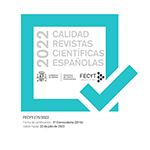La recepción de la lírica gallego-portuguesa medieval en Argentina. "Morriña" y estudios académicos al otro lado del océano Atlántico
Resumen
objetivo de este trabajo es dar cuenta de cómo la desdichada década del 30 española impactó, a través de sus exiliados, en la sociedad y la cultura de la República Argentina, y estableció un canon diferente del europeo con respecto a la edición de la lírica gallego-portuguesa. Con esta finalidad, se realiza un recuento de las publicaciones sobre el tema en la década del 40 y 50 en el ámbito editorial porteño. Por un lado, la temprana y señera antología Poesía gallega medioeval de los siglos XII al XV, publicada por Emecé en Buenos Aires apenas finalizada la Guerra Civil española (1941) por un encubierto Luís Seoane en la colección por él fundada, Dorna, puede leerse como un hito en lo que hace a la circulación y recepción de la lírica gallego-portuguesa fuera de España. Este primer impulso, seguido por la edición divulgativa de algunas cantigas en el Florilegio de la Biblioteca Vaticana de Francisco Luís Bernárdez en 1952 y la de ciertas publicaciones del Centro Gallego de Buenos Aires, parece fundarse en un sentimiento de morriña de quien está lejos de su tierra. De todas formas, este proceso se erigirá en producción académica con la obra de Claudio Sánchez Albornoz, presidente de la República Española en el exilio, quien inaugurará una nueva etapa para los estudios sobre España y sobre Galicia y la lírica gallego-portuguesa en Argentina. Un dato de interés del trabajo radica en el hecho de que en el recorrido que se propone se descubrirá que fue en este país donde se publicó por primera vez una antología de lírica gallego-portuguesa.Descargas
Descarga artículo
Licencia
La revista Madrygal. Revista de Estudios Gallegos, para fomentar el intercambio global del conocimiento, facilita el acceso sin restricciones a sus contenidos desde el momento de su publicación en la presente edición electrónica, y por eso es una revista de acceso abierto. Los originales publicados en esta revista son propiedad de la Universidad Complutense de Madrid y es obligatorio citar su procedencia en cualquier reproducción total o parcial. Todos los contenidos se distribuyen bajo una licencia de uso y distribución Creative Commons Reconocimiento 4.0 (CC BY 4.0). Esta circunstancia ha de hacerse constar expresamente de esta forma cuando sea necesario. Puede consultar la versión informativa y el texto legal de la licencia.








